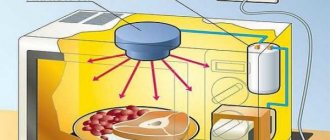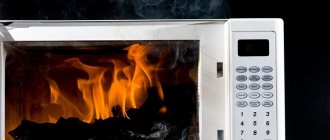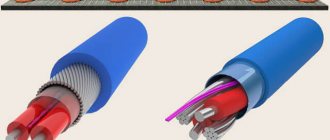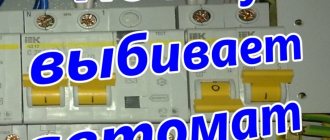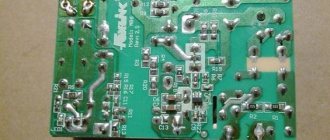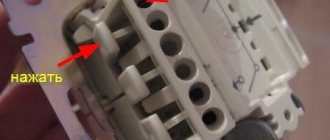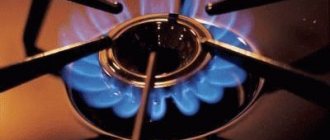How does a microwave oven work?
To make it much easier to troubleshoot problems found in your oven, it is worth familiarizing yourself with its main elements. The waves are generated thanks to a magnetron, which is connected to the camera by a waveguide. Power is guaranteed by a capacitor and diode. Therefore, it is possible that the microwave does not heat, but works.
There is another important element - this is a fuse that protects equipment from unexpected problems. The working chamber is an important part of the appliance in which food is placed to be heated.
To independently cope with equipment repairs when the malfunction is directly related to a defect in a certain element, you need to know the structure of the microwave. The magnetron is connected to the microwave chamber by a waveguide. The magnetron is closed on the camera side with a piece of mica or a plastic cover (this depends on the type of technology chosen). The failure of this component fully explains why the Panasonic microwave oven does not heat food.
In order to obtain high-voltage power, a special additional element (multiplier) was created. It consists of two main parts - a diode and a capacitor. A proven and high-quality fuse helps to avoid unexpected overloads. In addition, the manufacturers have provided one more point - a special lock on the switches makes it impossible to turn on the oven with the door open.
Professionals made sure that it was safe and easy for each user to reheat cooked food. But sometimes, for some reason, modern microswitches become damaged and no longer cope with their tasks, as a result of which the disk spins, but the microwave does not heat. It is important to constantly monitor this in order to avoid additional difficulties.
Specific commands are clearly visible on the device's convenient panel. The selection is made using special switches. Digital control is carried out using buttons; certain models have an easy-to-use touch panel.
What to do if the microwave oven turns but does not heat
To find out what the problem is if the microwave turns on but does not heat, you need to check the integrity of the main structural components. It is better to do this gradually or by elimination.
After all, if the microwave does not heat, the reasons may be simple, and eliminating them will take 2-3 minutes. Sometimes you still have to purchase a new part and perform a replacement. And here it is no longer possible to do without the procedure of complete dismantling of the structure. Be sure to unplug the microwave before starting to disassemble it . It is recommended to have the factory instruction manual at hand. As the malfunction is determined, you will need to become familiar with the relevant section in detail.
Initially, check the mains fuse. The fact of its burnout is not always determined visually. For reliability, the fuse is checked with a tester in ohmmeter mode. In this case, the resistance parameter does not matter. Current conductivity or its absence at all is established.
Other similar elements are checked in the same way. The high voltage fuse in the housing will show some resistance, but that's how it should be. Those fuses that have not shown conductive properties are considered illiquid - they need to be completely replaced.
Important! To avoid unpredictable consequences, you should never replace fuses with homemade devices. You risk creating fire and injury hazards and losing household appliances without the possibility of repair.
When going to the store for the appropriate spare part, take the failed analogue with you. This will save both time and money.
If all the previous parts are intact, and the microwave oven still does not heat, move on to the multiplier (or doubler) unit, which consists of a high-voltage diode and a capacitor. Using the same ohmmeter, the serviceability of the capacitor is checked.
If the indicator briefly shows insignificant resistance and immediately switches to the “infinity” sign, this is typical for serviceable capacitors of this type. If it shows nothing or a slight resistance without changes, it means that the capacitor is “broken,” that is, faulty.
It is recommended to replace the diode that is present in this assembly along with the capacitor. It is difficult to check its performance at home, and the cost of such a part is low.
Next, check the filter capacitors on the body of the electromagnetic lamp. They will need to be pre-discharged by “shorting” the contacts to the housing using an insulated screwdriver. Check each contact in turn through an ohmmeter to the negative bus of the device.
If the device shows at least some resistance, this is normal. If it is zero, the part must be replaced. Also check the capacitor contacts for breakdown. The normal resistance between them should be within 0.1 Ohm.
To test a transformer, the resistance of all its working windings is measured. In this case, you will need reference information from the instruction manual. Knowing the parameters for each of the transformer coils, it is easy to determine its condition. Pure resistance values will not help. Test ratings are given taking into account the electrical circuit parts included in the circuit.
And now we get to the main reason why the microwave turns but does not heat. It is connected to the magnetron. This is a powerful lamp that generates electromagnetic waves of a certain frequency (0.5-10 GHz) when an electron flow interacts with a magnetic field. Due to exposure to high temperatures and magnetic fields, the contacts and soldering of this unit are often damaged.
First of all, carefully inspect the contact connections of the filter induction coils, the magnetron power terminals with filter capacitors. If necessary, contacts can be easily restored at home.
Important! The magnetron lamp is capable of heating the housing and adjacent parts to temperatures above 150°C. Allow the appliance to cool completely to avoid serious burns.
As in previous cases, check the resistance of the magnetron filament. It should be within 2-3 ohms. Violation of parameters indicates a malfunction of the magnetron. To replace it, you will need exact technical specifications, which should also be in the information part of the instruction manual.
There is some skepticism about the cost-effectiveness and possibility of replacing the magnetron tube yourself. Some still advise using the services of service centers, while others recommend purchasing a new microwave.
What to do if the microwave does not heat
The key to proper and, most importantly, long-term operation of a microwave oven is careful operation of the equipment. A foreign object may accidentally enter the camera. You should not heat food in dishes made of metal, this will lead to trouble. To determine why the Bork microwave oven does not work, you need to conduct a comprehensive diagnosis. No special skills or equipment are needed for this; available tools will suffice, provided that the user follows professional recommendations.
Our service center offers its services for repairing household appliances at a competitive price. We repair any breakdowns of modern household appliances. Leave a request and get a 15% discount - Leave a request
What to do if the microwave heats up but does not spin? It is absolutely not necessary to immediately contact the service center for help. It is necessary to identify the damaged component, and then repair the part or replace it with a new one.
The microwave oven works and does not heat
The situation when the microwave works but does not heat food occurs for many users. How to figure out the cause and what to do if the oven does not hum, the food on the plate is spinning, the ventilation and lighting in the chamber are working. That is, there are all the signs of normal operation, but without the desired result.
The simplest reasons
The microwave will not heat food:
- If there are large voltage drops in the linear network. Already at 200 V, the food in the dish will not heat up completely and will remain cold in the center. To correct the situation, you can use a voltage stabilizer or connect an uninterruptible power supply.
- If the latch on the door is broken and it does not close tightly. It can be repaired or completely replaced.
- When connecting more than two high-power appliances to one outlet. You can additionally make a separate connection.
- If the mode is mistakenly selected incorrectly. For example, they forgot and did not switch it after using the defrost mode.
If the simplest reasons are not suitable for your case, then there is a more serious reason for the lack of heating.
Why problems might arise
The microwave is working but the food is not heating, it will be important for you to know that certain factors are often the cause:
- Difficulties arising with the supply voltage: to eliminate the cause, it is worth purchasing a power supply of the specified power.
- Failure of parts - over time, the design stops working correctly, the door does not open well and the dishes do not warm up completely.
- Setting the random mode.
- Presence of unnecessary objects in the chamber.
Constantly monitor the serviceability of the selected microwave oven.
If your LG or Samsung microwave does not heat, be sure to check to see if the warranty period has expired. It is possible that the cause of the breakdown of household appliances was a manufacturing defect.
To determine the reasons why the microwave does not heat and is noisy, carry out a comprehensive diagnosis. Start with a visual inspection of the walls of the heat chamber and the power cable. If the microwave does not heat, you need to disassemble the device to check the functionality of the components.
It is important to know that problems in the proper operation of a microwave often lie in its careless use, violation of basic rules and recommendations. As a rule, it is mainly very cheap models that become faulty; their parts wear out quite quickly and easily. Remember that it is the users themselves who are to blame if the microwave oven refuses to heat food properly. People neglect the rules, and then suffer from the poor performance of purchased home appliances. When heating food, be sure to take special dishes and under no circumstances turn on the oven completely empty; such equipment is not provided for this.
Pay attention to some important points: the fuse has a glass bulb and metal elements. When you see a break in the chain, you need to replace it immediately.
Difficulties with the magnetron - poor quality and untested contacts (due to constant heating). The solution to this problem is simple - restoring contact using special tools. Has the cap turned black? You have to make an effort to clean it carefully. The antenna cap is damaged - carefully inspect the magnetron itself, make sure the element is in good condition. Replace the cap, and, if necessary, the magnetron: the new parts must match the installed ones in terms of power and structural features.
To prevent equipment from being used with the door poorly closed, special small switches are installed. It is important to know that often the reason why a microwave does not heat can be due to defects in the microswitch. This will require urgent replacement of parts.
Always be careful about the rules for using the selected devices. If necessary, contact trained specialists and experienced craftsmen.
Possible serious damage
Why did the microwave stop heating? If all of the above options do not work, then the cause of the malfunction is more serious.
You need to remove the back wall of the microwave to get to the burnt part.
Fuse
To protect more expensive parts from damage, the fuse often takes the first blow. If it burns out, then the breakdown is not considered serious.
To remove the fuse from the microwave, you must first find the protective casing. The part looks like a glass flask with metal caps. A wire with a spring is applied to them. This design is necessary to calculate the impact that falls exactly on the fuse. You can determine whether an element has failed by visual inspection. If the fuse is blackened and there is a burning smell near it, you will have to replace the part. In addition, the voltage is determined by a special device. If it is, then you need to look for the problem in something else.
For those who know how to solder, you can try to make the repairs yourself. To do this, you need to remove the cap, find the torn wire and solder it in place. While replacement is easy, the parts themselves are hard to find. The service center will help you.
Before any complex repair procedure, you need to make sure that the microwave is disconnected from the power source.
Capacitor
This is also one of the reasons why the microwave does not heat. In addition, extraneous noise and hum appear in operating equipment. To see if the capacitor is working, you need to arm yourself with an ohmmeter. Be sure to wait until the part is completely discharged.
When measuring, you can find the following:
- weak resistance - the part is faulty;
- there are no capacitance contacts if the needle on the ohmmeter does not move at all;
- the arrow points to the infinity sign - the device is working properly.
After diagnostics, it is easy to understand whether the capacitor needs to be replaced.
Diodes
They are important in converting the AC to DC power supply for the magnetron. A diode malfunction is accompanied by a humming sound from the microwave. It can be checked using a multimeter. Diodes direct electricity in one direction and must have a higher resistance at one end and a low resistance at the other. If you find that the resistance is the same on both sides, then the part is faulty.
Microwave Internal Parts
Magnetron
This is the component that produces microwave radiation that heats food. It is very important. Magnetrons require a lot of power, so if there is any malfunction, it will affect the fuse. You can check the resistance with an ohmmeter - it should be 2 or 3 ohms. If the readings match, move one of the test probes to the metal housing. The arrow should not be on o. If it lingers there, it means there is a problem.
In such a situation, the fuse burns, but replacing it alone will not solve the problem. You will have to think about purchasing a new magnetron.
High voltage transformer
High-voltage diodes are used to power the magnetron. These are some of the most difficult parts to replace. And unless your microwave is new and high quality, you should probably consider purchasing a new appliance.
The microwave works, but does not heat, the reason is the transformer. If a lot of smoke is generated, then this definitely indicates a breakdown. Experts recommend checking the winding to find out if there is a short circuit. In any case, you will have to change the elements to resume operation of the device.
It is better to have your microwave repaired and do not try to solve this problem yourself. This requires special skills and abilities.
Mica plate
Opening the door to the oven chamber, you can find this part on one of the walls. The reason that the microwave does not heat well may be simple dirt. Often, equipment owners do a poor job of cleaning the inside of the cabin from grease, and as a result, plaque forms. It interferes with the normal operation of the microwave. Fat cracks and sparkles under the influence of rays. To clean the mica, you need to unscrew it from the wall of the microwave. Next, you should run sandpaper over its entire surface to remove all dirt. After this procedure, the microwave works well again. If you see holes in the plate and smell an unpleasant odor from there, then the breakdown is more serious and a complete replacement of the mica is required.
Mica plate in microwave oven
Inverter
If the microwave works but doesn't heat, something might have happened to the sensor. We need to check the inverter. He himself determines the temperature of the product, setting the desired degree for heating. If it breaks, the food will not be heated. In this case, you need to replace the inverter with a new one. Repairs are not enough here.
Control block
It is not recommended to disassemble the microwave. If you do not have sufficient experience and understanding of how the equipment works, it is better to take the device to a workshop. The control unit cannot be repaired alone. Here you need the help of a professional, because you will have to reflash or change the control board.
Timer
This is one of the parts that also requires replacement by a specialist. You cannot repair the timer yourself. How can you tell if it's not working? The microwave does not heat up or does not turn off for a long time, shows the wrong time, etc.
The film from such containers must be removed. And set the heating time from the instructions.
The microwave does not heat - simple reasons
You decide to heat up a dish, the microwave works, but the temperature of the food does not rise. The reason can be either simple or complex. If the voltage is low, you need to install a stabilizer to correct the situation. Once you determine why the microwave is not heating food, you need to start repairing it. Is the furnace switched on in line with other appliances? Then switch some of the equipment to other outlets. Also make sure that the oven cord is not damaged.
Even old wiring can explain why the microwave stopped heating and defrosting food. Don't forget about preventive measures. It is extremely important to regularly clean the heat chamber from splashes of grease and food debris. To avoid unpleasant odors, use plastic lids and hoods.
Serious causes of microwave malfunction
If you have checked and gone through all of the above, why doesn’t the microwave work? The reason may turn out to be much more serious - and require equally serious repairs to the internal parts of the equipment.
Fuse
Fuse in the microwave oven
We continue to find out why the microwave oven works but does not heat up. Here is, perhaps, the most “light” option of all possible - a fuse. It is designed to take “all the fire” and protect more expensive and valuable elements from damage. You will find it in a protective case - the element is visually similar to a glass flask with iron caps. If the fuse is blackened or there is a burning smell from it, it needs to be replaced. Also, do not forget to check for voltage using an ohmmeter or other tester.
The reason why the microwave stopped heating: sometimes the wiring inside this “cone” comes off. Remove the cap from the fuse and solder the “runaway” wire in place. In most cases, this is enough to return the microwave to working condition.
Mica plate
Microwave mica plate
The microwave has stopped heating, but is it still working? We look at the mica plate. This element is located on the side inner wall of the oven - you can check its condition without even disassembling the equipment. If there is a thick layer of fat or carbon on the record, then when heated you will hear a crackling sound and even notice sparks. When the mica plate is not cleaned at all, you can even expect a fire inside the kitchen appliance.
Again, you need to solve the problem using regular sandpaper. Remove the plate by unscrewing it with a screwdriver and sand it to a decent condition. Return it back and check the operation of the equipment. If the element is so neglected that holes are visible in it, the situation can only be corrected by purchasing and installing a new plate.
More serious reasons
If the food does not heat up, the microwave oven does not turn on, or some modes stop working, then these are the first signs of serious malfunctions. Why doesn't the microwave heat up? Hardware components come out due to:
- normal wear and tear;
- mechanical damage;
- improper operation of equipment;
- short circuits.
To determine why the microwave beeps but does not heat food, and then fix the problem, you need to buy the appropriate spare parts.
Fuse
If the microwave disc is spinning and the light is on, but the food is not heating, then you should contact a professional. They will help you cope with the situation.
Fuse blown:
- Remove the cover.
- Blown fuses turn black or swell.
- Check resistance.
- Replace parts with proven and high-quality ones.
If the microwave operates but does not heat, disassemble the oven to check the functionality of other parts. It is possible that another component, for example, a magnetron, has broken.
In order to carefully examine the general condition of the fuses, you need to carefully remove the cover, removing the fasteners. The light in the microwave itself does not come on if the mains fuse is faulty. If you do not notice any serious external defects, then take an ohmmeter to check its condition. You can also pay attention to the condition of the cord and plug itself; they must be of high quality and without damage. This condition must be observed. There is a high-voltage fuse directly under the casing; this should also be checked. The safety of using a microwave oven depends on the reliability and serviceability of the parts.
Magnetron problems
If the microwave hums but does not heat, this may indicate problems in the magnetron. A malfunction of this part causes the microwave to turn on but not heat well. There is no need to immediately blame the magnetron for everything; this is due to the fact that well-known brands, for example, Samsung, may have problems with the solder joints of the filter coils when the lamp is operating. Remember that these difficulties can be eliminated quite simply without the help of specialists. But if there are no problems with soldering, you will need to pay attention to the channel thread.
You need to know one more rule in order not to make a mistake - the magnetron housing heats up to one hundred and fifty degrees during operation. It is for this reason that when the microwave was turned on, it was necessary to wait until the lamps cooled down. When you have checked everything and the food is not heating in the oven, replace the magnetron. But keep in mind that the new part must strictly comply with the established parameters and characteristics. You can make a replacement either yourself or by contacting the specialists whom you trust to solve this problem.
Problems with mica plate
What is the reason that the microwave does not heat food? If, after a detailed and careful check and replacement of parts, the oven turns on, but does not heat the food, an additional check of the mica plate will be required. A mica plate is necessary to cover the exit of the waveguide directly into the microwave chamber. If there is carbon deposits on the part, it will interfere with the proper operation of the oven. When serious defects appear, sparks may occur, and this, in turn, will lead to an unexpected fire. All your actions must be well thought out.
Carefully clean the plate from dust, and then carefully, following the rules, put it in place. Please note the following point: if you notice a hole in the plates, replace them as soon as possible. Show responsibility and you will prevent serious troubles from occurring.
This element can be purchased separately in the store without any problems. At the same time, if you purchased a plate from Samsung, but you need a component for Sharp, you will have to make holes for the screws.
Capacitor burnt out or diode faulty
What could be the problem if the oven stops heating? Check with a tester to see if the capacitor or diode is broken. When a problem is identified, the parts are changed. Take care of your chosen microwave oven, and then it will delight you for many years with its serviceability and positive characteristics. If problems do appear, then it is necessary to urgently begin to eliminate them. You can entrust the work to professionals or, if you have experience and relevant knowledge, cope with the tasks yourself. Do not ignore the instructions and instructions for using the purchased equipment. Valuable recommendations will help you prevent unexpected device failure.
Broken multiplier:
- Resistance will indicate a problem.
- Check the diode itself.
- Damage to the magnetron.
Often, problems of this kind can be eliminated with simple efforts, without outside help: you just need to understand the documentation and replace the part. But this will require patience and careful attention to detail.
When the microwave was turned on, the light began to come on, but the equipment still does not perform specific tasks, under no circumstances should you throw it away, everything can be fixed. The whole point is that you violated certain rules for using the device. Anyone can face this problem. Eliminating defects does not always require special knowledge and skills.
If the microwave breaks down, first use the instructions, as they contain hints from the manufacturer as to why the oven may fail. If a solution is not found, check the voltage, also disconnect the device from the network and check the microswitches.
A multiplier is a part that consists of a diode and a capacitor. The reliability of the capacitor can be checked with an ohmmeter. Here you will need minimal knowledge: you saw that the device’s arrow deviates, then points to infinity, then you can say with complete confidence that everything is in order with the device. But when resistance is detected, it means there is a breakdown. This moment (problems with the capacitor) is indicated by the peculiar behavior of the equipment: it hums, but does not do the work. Replace the diode with a serviceable and high-quality one.
To repair a microwave, you need to check the component with an ohmmeter. If the readings are 0.1 Ohm, everything is fine, you can rest assured.
Diagnostics
You need to start, as you should, by carefully reading the instructions for the device. There should be a detailed diagram with the parts and design mechanisms marked on it, as well as the manufacturer’s recommendations for troubleshooting problems.
Use the instructions to troubleshoot any minor problems you may have.
If you don’t have any documents left for the stove, then try to find a description and diagram of your model on the Internet. There may also be practical advice on repairs on various forums.
If you don’t want or are afraid to figure out the problem yourself, call a technician or take the stove to a repair shop.
It is important to follow safety precautions as there is a risk of electric shock!
If you are determined to fix the breakdown yourself, then look for the instructions for the stove, collect additional information and let’s figure out the sequence of further actions to identify the causes of the breakdown. Prepare in advance the special devices and tools that will be needed during the diagnostic and repair process: a multimeter or tester, an ohmmeter, an electrical screwdriver (insulated, with a light bulb tester in the handle).
Digital multimeter with network voltage indicators on the display
Before you start disassembling the equipment, measure the mains voltage . You may have already noticed that the light bulbs in your home are dim, flickering, or constantly burning out; other household appliances work intermittently - all these are symptoms that the voltage is too low. According to GOST, the indicators should be in the region of 220 ± 10% V, that is, from 198 to 242 V. In practice, even small deviations of 5-10 V from the standard 220 can already cause a problem when the microwave works but does not heat.
At low network voltages, it is recommended to: install an uninterruptible power supply; do not use all household appliances at the same time, especially do not plug them into one outlet through doubles or tees.
If everything is normal with the voltage readings, then you need to check its supply to the primary winding of the high-voltage transformer when you turn on the microwave oven. It is important to follow safety precautions as there is a risk of electric shock!
The next step is to unplug the microwave. On a de-energized stove, carefully inspect the door latches . Sometimes poor heating is caused by the door not closing tightly as a result of broken latches. In this situation, the latches will need to be repaired or replaced. The functionality of the miniature switch on the door is checked using an ohmmeter.
The latches on the microwave door ensure that it closes tightly.
Having ruled out problems with the door, we proceed to disassembling the microwave oven and inspecting the internal parts.
If it so happens that the microwave operates but does not heat, and the warranty period for your equipment has not yet expired, do not make any independent attempts to unscrew the screws or disassemble the oven. Contact the service center specialists immediately.
Remove the top cover - to do this, unscrew the screws on the side panel. Having looked inside, the first thing you need to pay attention to is the reliability of the soldering of the contacts at the joints of the parts and the fuses (usually there are two of them).
Fuses look like miniature incandescent light bulbs with a spiral inside.
If any of the fuses has turned black or it is noticeable that the filament inside has burned out, then this part must be replaced to fix the problem. To avoid making a mistake in choosing the model you need, take the blown fuse with you and buy exactly the same one.
The next point in diagnostics concerns identifying problems in the components of the multiplier, primarily the capacitor .
A high-voltage capacitor is a device for storing an electric field. Has one input (with a voltage of 2100 V) and two paired outputs for connecting a diode and magnetron anode
You can guess about malfunctions in the capacitor in advance when, when turned on, the microwave makes buzzing and other extraneous sounds.
Before checking or replacing capacitors, they must be completely discharged with an electrical screwdriver, one by one connecting the terminals to the housing.
The test is carried out using an ohmmeter. If the capacitor is working properly, the tester needle will first deflect and then go to infinity. If the arrow does not deviate, it means the part is faulty or the contact is broken. In the event of a breakdown of the capacitor, the device will immediately show a small resistance and the arrow will remain in one place. Testing with an ohmmeter will not reveal changes in the capacitance of the capacitor, and the voltage parameters between the anode and cathode depend on it, which may be the reason that the microwave operates, but does not heat or heats poorly. Therefore, if you still have doubts, it is better to change the capacitor.
It is recommended to immediately replace the diode that is connected to the capacitor with a new one so as not to waste time checking it
A faulty diode can be indirectly indicated by blown fuses or an overheating capacitor, which begins to hum and buzz when the stove is turned on.
The filter pass-through capacitors on the magnetron housing are also checked. They need to be discharged, then one ohmmeter probe is placed on the terminal of the capacitor, and the second on the metal case. Zero readings on the device indicate a faulty part. When checking contacts to detect breakdowns, the normal resistance between them is considered to be 0.1 Ohm.
Troubleshooting
A huge number of reasons why a microwave oven does not heat can be detected and solved quickly and in a timely manner. First of all, you need to prepare some tools in advance - a screwdriver, measuring instruments. These include an ohmmeter - a device that will do an excellent job of diagnosing problems in a microwave oven.
Microwave works but doesn't heat well? Troubleshooting methods:
- Incorrectly marked mode - use the instructions to set the desired command (“warm-up”); turn on the oven for a while and make sure that the food is heating up - the problem is solved.
- Insufficient voltage - take care to install an uninterruptible power supply.
- Problems with the normal functioning of the door - replace parts.
If the microwave oven is no longer in good working order and cannot cope with direct tasks, first refer to the instructions, which contain a list of tips and valuable recommendations on why the oven fails. If you don't find a useful answer, check an item such as voltage. If everything is in order, unplug the oven and check other elements - microswitches.
In some situations, it is impossible to restore a non-working Samsung microwave or a device from another manufacturer. Even troubleshooting a magnetron is too costly a process. It is more rational to purchase new equipment.
Causes of breakdowns and repairs
Let us outline the possible causes of malfunctioning microwave ovens. To understand why the microwave works but does not heat, it is important to determine exactly which of the reasons fits your case, as this will greatly simplify the process of eliminating it.
To independently determine why the microwave is not heating, you need to do the following:
Check wiring. Use a bright light source. All wires and contacts must be clean, without traces of burning. If the wire windings are blackened or melted, they should be replaced. In addition, you need to clean all terminals and contacts with fine sandpaper or a metal brush. Due to oxidation of contacts, the oven may not operate correctly.
Check voltage . We need to find out whether it corresponds to the norm. This can be done using a voltmeter. Attention! Even a small deviation in voltage can cause a microwave oven to malfunction. It's not a fact that the microwave is broken. If the voltage is really less than the required 220 Volts, you need to purchase an uninterruptible power supply unit and only connect the stove to the network through it.
Check the door switch . To check the operation of the miniature switch located on the door, you will need an ohmmeter. It is necessary to remove the back cover of the device and find out whether the switch works using an ohmmeter. Don't forget to turn off the power to the microwave!
Check the high voltage fuse . Without putting the ohmmeter aside, we check the resistance of the fuse. The problem is not critical if the resistance is small. Take a closer look - if there is no visible damage (the fuse is blackened, there is an unpleasant smell or a burnt wire), use the tester to be completely sure.
Check doublers . Again, we don’t part with the ohmmeter; with its help we will find out whether the capacitor is working. The arrow on the device remained motionless - the device is faulty. In this case, it must be replaced. Using the same method, you can also correct deviations of the arrow by several units, since the part is broken.
Check the operation of the electromagnetic lamp . In addition to the ohmmeter, we take an electrical screwdriver with a protective handle. What happens is that we use a screwdriver to discharge the lamp capacitors. We measure the resistance with an ohmmeter. A little resistance is considered normal. The part needs to be replaced if there is no resistance or jumps. An acceptable value is approximately 0.1 Ohm.
Check the primary winding of the transformer . Here it is worth using a tester. The voltage should be 220 Volts. One way to check is a simple glass of water. Place it in the oven, then check if it is warm. If the water temperature has not changed, the primary winding should be replaced.
Check the magnetron . We're not talking about films here. It's getting more serious. This is the part responsible for creating the high-frequency electric field with which you can heat up food. The first step is to check the integrity and reliability of the connection between the magnetron and the feed-through capacitor, filter induction coils and power terminals. The malfunction can be eliminated independently. Also check the lamp filament. Approach the matter thoroughly - take a tester. The filament of the magnetron should be within 2 - 3 ohms. If all of the above procedures did not help to identify the essence of the matter, then the problem may be in the lamp itself, namely, the magnetron does not turn on. You should be careful with her.
Tip: There are many parts in a microwave oven that may be faulty. When you have determined which of the furnace elements is faulty, it should be replaced or entrusted to a professional to repair it. Repairing furnace parts at home will be almost impossible if you do not have experience. In order to save time for yourself and the seller or technician, you can write down the technical parameters of the faulty parts and feel free to go to the store.
Preventing damage
We looked at how to determine the cause of a malfunction, as well as how to repair a Sharp microwave oven with your own hands. Now is the time to talk about prevention, which helps prevent failure of the basic components of the stove. You can avoid serious damage by following a few simple tips:
- Under no circumstances should food be heated in metal containers;
- do not turn on the oven without placing a dish or product in the heat chamber;
- You can’t heat eggs;
- heat food in plastic containers with lids.
These are the basic rules for operating microwave ovens. More useful information can be found in the user manual and technical documentation.
Why doesn't the microwave oven heat up food?
Why doesn't the microwave heat up?
Why doesn't the microwave heat up? A microwave oven may refuse to do its job for various reasons:
- You are used to heating food in metal containers.
- You heat food in a tightly closed container or plates with shiny decorations and details.
- You are unlucky to buy low-quality cheap equipment.
- The microwave has reached a certain age; its parts are failing due to natural wear and tear.
Rules for caring for a microwave oven
In order not to have to figure out why the microwave oven does not work after a short period of use, you need to properly care for your household appliances. Rules for caring for your microwave:
- The heat-resistant glass tray must be washed with liquid soap.
- Do not use abrasive powders to clean the grates, they just need to be "soaked".
- Promptly remove any remaining fat or food from the surface of the chamber.
- The most unpretentious in maintenance is a microwave with internal walls made of stainless steel; they can even be cleaned with abrasive agents.
- Under no circumstances should the oven be cleaned or washed while it is on.
- After cooking, wipe the oven with a microfiber or lint-free cloth dampened with plain water.
- To remove condensation from the walls of the microwave oven, wipe them with an ordinary napkin.
- If the oven is very dirty, do not use the grill or convection mode, otherwise the grease will turn into brown spots.
- Use cleaning products labeled as Microwave cleaner.
- There is no need to touch the ventilation, as well as the compartment in which the magnetron is located.
These simple tips will help your microwave operate longer.
Repair depending on breakdown
If the fuse is broken, you won't be able to find out without removing the back cover. The light in the camera that goes out will tell you that the mains fuse has blown. Did the wire survive? Get out the ohmmeter and do a serious check. The same tool is useful for examining the high-voltage fuse (hidden under the casing). Even a small resistance indicates a false alarm - the breakdown will have to be looked for elsewhere. If the fuse is blown, it must be replaced.
UE error on Samsung washing machine
The multiplier deserves special attention - this part consists of a capacitor and a diode. You can use an ohmmeter for this. A sure sign of a faulty multiplier is the buzzing of the microwave when there is no heating. You won’t be able to check the diode yourself - it’s better to change it right away (it costs pennies). Now - feed-through capacitors. You should look for these spare parts inside the high-frequency lamp. If you want to make sure that the Samsung microwave does not heat up for this reason, proceed as follows:
- Discharge the capacitors.
- Test each part with an ohmmeter.
- Make sure that the device displays a value of 0.1 Ohm (functional).
- A zero parameter indicates a breakdown.
- Replace the unusable part.
The microwave may also hum due to a malfunction of the magnetron. The filament is checked with an already familiar tool - an ohmmeter. The normal resistance parameter is two to three ohms.
Useful tips
In order not to waste time determining the reason why the Daewoo microwave stopped heating, you need to adhere to the basic rules for operating the equipment:
- toxic cleaning powders can get into food or damage the magnetron;
- dirt and grease from the body can be removed with a damp cloth;
- to remove dirt from the door, use a damp sponge and wipe the insulation;
- It is advisable to wipe touch panels with dry wipes;
- to get rid of an unpleasant odor, heat a glass of water with a slice of lemon;
- Reheat food by covering it with a special plastic lid to keep the walls of the heat chamber clean.
If the enamel inside the microwave has peeled off, be sure to paint over the damaged areas.
How to fix simple problems yourself
How can this be? The microwave seems to be broken, but continues to work: the plate is spinning, the lights are on, and the food is cold.
The device stops heating for several reasons. Before disassembling the housing and looking inside the microwave, you should study the operating instructions, which indicate the most common breakdowns and how to fix them. First, let's deal with the simplest problems:
- One of the common reasons why a microwave oven stops heating is insufficient voltage. For normal operation, the device requires a voltage of 220 volts, a decrease of which by just 10-20 volts will be insufficient to heat food. This can be eliminated by installing an uninterruptible power supply.
- Network overload. To prepare food, especially on the eve of the holidays, several electrical appliances are often used. Some sockets are not able to withstand such a load, so the device does not work fully or turns off altogether. In this case, do not use tees and carriers, but connect each device to a separate outlet or use it in turn.
- Door latch malfunction. In order for the door to fit tightly, you need to adjust the latch.
If such causes have not been found or have already been eliminated, and the stove still does not heat, then the problem lies even deeper.
Complex breakdowns: 6 reasons
The microwave hums but does not heat - this may indicate a serious malfunction. Some of them can be eliminated with your own hands at home, while others will require more serious and professional intervention:
| Reason 5. High voltage fuse This is the part whose failure can lead to the microwave not heating. Solution: the oven has two such parts, if at least one of them is blackened or scale has formed on it, replace it | |
| Reasons 6. Feed-through capacitors This breakdown is indicated by extraneous buzzing and internal noise. Solution: the capacitor needs to be discharged before maintenance - take an ohmmeter, connect it to the capacitor and check its serviceability | |
| Reason 7. High voltage diode To determine whether a diode is faulty, you need to use a high-voltage capacitor. If it breaks, it will not heat up. The main signs of grinding will also be buzzing and burnout. Solution: if it breaks, replace the part | |
| Reason 8. Magnetron The oven stopped heating if the magnetron went out of working condition. The main symptom is a strong hum. Solution: replace with a new part | |
| Reason 9. Filament The filament is located in the magnetron. First, check the primary winding of the thread - often the thread breaks or frays. Solution: replace the part, do it better in a workshop | |
| Reason 10. Electromagnetic lamp If the electromagnetic lamp has burned out, the microwave oven may operate, but will not heat food. The solution is to replace it through the back of the case:
|
Before carrying out any manipulations, check the microwave and disconnect the power system from the electrical network. Use the instructions for the microwave oven.
